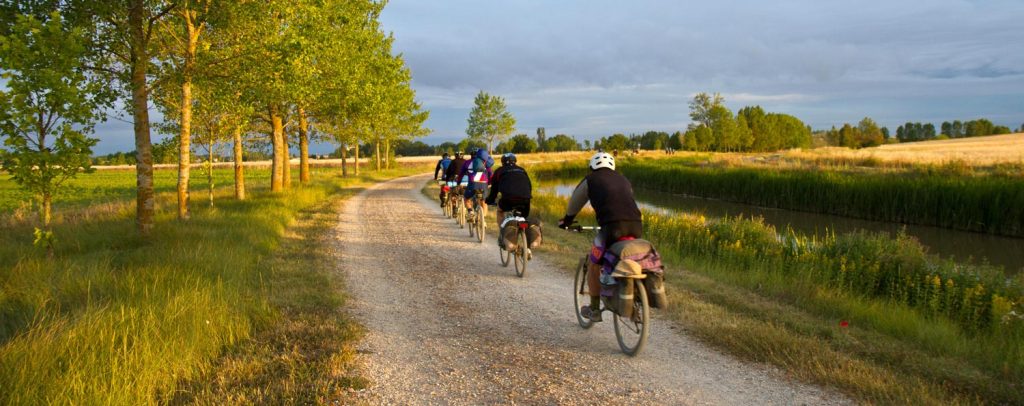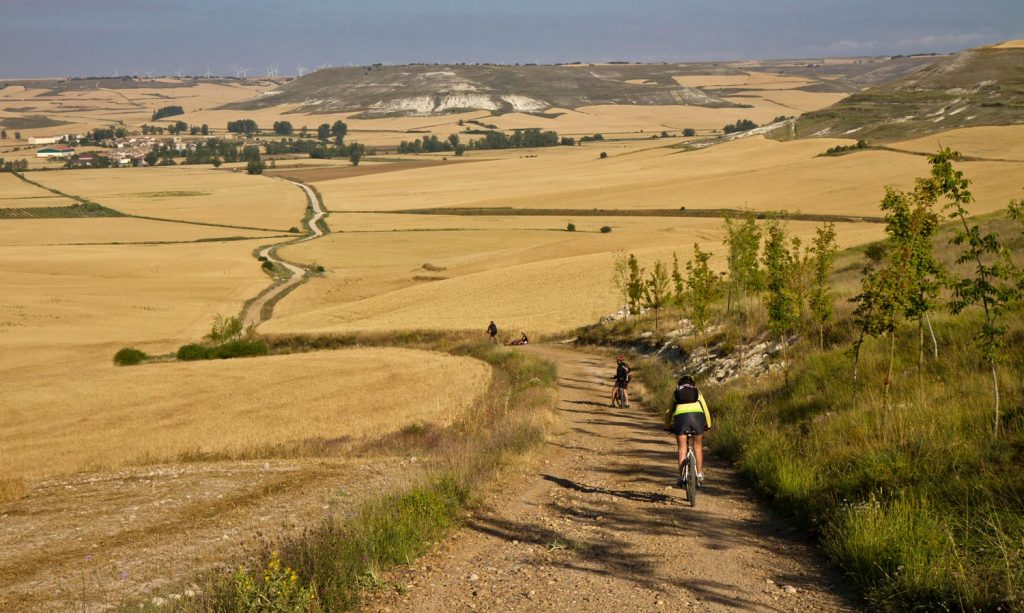Frequently Asked Questions – Biking the Camino
LOGISTICS
I’ve walked the Camino. Why consider biking it?
You can cover more distance per day on a bicycle, so you can complete your trip in much less time or choose a more ambitious route. There is less strain on your body as the bicycle carries the weight, especially if you have back or joint issues. You can explore off-route points of interest more easily. For a more complete comparison of walking and cycling, see Why Bike the Camino?
I love Bike Touring, so why should I consider the Camino for my next trip?
The Camino is a historical route steeped in pilgrim history and folklore. You don’t need to plan much as you can rely on inexpensive pilgrim hostels every 5-10 miles that don’t need to be booked in advance. Resupply of food and water is frequent and there are bike shops every day or two. You can avoid traffic with most of the route being off-road. You can meet other cyclists and walkers from around the world. For more on what makes the Camino a great bike tour, see Why Bike the Camino?
How long does it take?
That will depend on how much distance you can cover per day as well as where you want to start and end. For the 800 kilometer Camino Francés, we offer suggested itineraries for 7, 13 and 20 days. See Itineraries for more ideas. A common time period is about two weeks, at an average of about 60km per day.
How much cycling experience do I need?
The Camino can be a great first tour, so don’t feel intimidated if you have never done a multi-day tour before. However, you do want to be comfortable on a bicycle for extended periods and have experience on varied terrain. See our training plan for suggestions on training for your tour.
How strong and fit do I have to be?
You don’t need to be a hardcore cyclist to complete the Camino, but you will need to be in reasonably good shape. A determined person of average fitness should be able to complete the Camino if they dedicate the necessary time to train. See our training plan for suggestions on training for your tour. Keep in mind that biking the Camino isn’t necessarily easier than walking the route, given the elevation change each day, especially in the Basque Country, Cantabria and Galicia.
Where do I sleep?
There are many options on most Camino routes, especially the Francés route. There every 3-10 miles there are inexpensive dormitory accommodations in pilgrim hostels or albergues. A variety of private accommodations from simple pensiones to luxury hotels also exist. Camping is really not necessary given the infrastructure of hostels and the lack of campgrounds. See Accommodations and Resupply for more details.
Where do I get food and water?
You will pass numerous grocery stores, cafes and restaurants each day on the Camino Francés, so there is no need to carry food beyond snacks for the day. Most towns have public water fountains or you can easily refill in a cafe or purchase bottled water. See Accommodations and Resupply for more details.
What do I need to know about cycling laws in Spain?
Helmets are required most of the time; While there are some minor exceptions it is best to simply wear a helmet all the time when cycling or risk a €200 fine. Reflective clothing and lights are required when necessary (early morning, dusk, tunnels, rainy weather, etc. similar to when a car is required to have lights on). LED lights are not necessary on the Camino unless you plan to ride in the dark (not recommended). Headphones are prohibited while riding (even if only in one ear) or €190 fine. Always ride with traffic (right side of road). Obey all traffic signs. Ride single file. Carry a bell to warn pedestrians. For more on cycling laws in Spain see Cycling in Spain.
Can I take the walking route or is there a separate path? How do cyclists interact with walkers?
Cyclists can take the same path as walkers, which is paved close to half of the time (either following roads or a paved multi-use path.) There are often possible road detours that cyclists can take to avoid rocky or challenging walking paths.It’s very important to look out for walkers and treat them respectfully, as there is sometimes a sense of enmity between cyclists and walkers. Always remember that walkers travel much slower than you, and usually cannot hear you approaching until you are very close. Use your bell and/or shout “biker,” “hola,” or “buen camino” well in advance and slow down to pass walkers safely. Be especially aware of walkers on when descending, as reaction time is reduced. It’s very common for walkers to express frustration that fast cyclists quickly overtake them, startling the walkers and sometimes even running into them. You will need to carefully control your speed and be very patient in busy areas where you are frequently overtaking walkers.
BIKES & GEAR
What bike and gear do I need?
A variety of bicycles can be suitable for the Camino, the most important factor is capacity to ride on rugged dirt paths and ability to carry the gear you need. The most common setup is a mountain bike with rear rack and panniers. You will also need some basic bike tools, lock, tire pump, and spare inner tube. Your clothes and shoe choices should be suitable for cycling. Otherwise the gear you bring will be similar to what a walker would bring, see our walker packing list at www.caminoguidebook.com.
How do I get a bike to the Camino?
There are three main options for getting a bike to the Camino.
- Rent a bike in Spain; There are many bicycle rental outfitters with extensive experience and expertise in outfitting bicycle pilgrims and the overall costs are comparable to the cost of bringing your own bike from outside of Europe. You can also rent panniers, racks and other accessories.
- Bring your bike from home, but be aware that many airlines have high fees for checking a bicycle, and you will need to either box your bicycle or pack it in a hard-sided case. Trains and buses also have added fees for bicycle transport, and some require that bicycles be boxed. Weigh the cost of bicycle transport and any additional gear you may need to purchase, and compare this to the cost of renting. You may also wish to insure your bicycle against damage or theft (an additional cost to consider). The big advantage of bringing your own bike is having a bicycle and gear you trust and are familiar with.
- Purchase a bicycle in Spain. There are many bike shops that sell good quality bicycles in larger cities in Spain. Some people have had luck with reselling their bike once they arrive in Santiago, but there is not a foolproof system to do this reliably, so you may not be able to recoup much of your original cost. To buy a good quality bike and gear would likely cost quite a bit more than renting, though there are reports of folks completing the Camino on very inexpensive low-quality bikes (but they are known to break down often).
How do I carry my gear?
The main options to carry gear on a bicycle are a rack and panniers (saddlebags), bikepacking bags, trailer or backpack. For the Camino, bike packing bags or a traditional rear rack and panniers and a handlebar bag are likely the best options unless you already own and are comfortable with an alternative. It is really not recommended to carry all your gear in a backpack, due to comfort, ventilation and bicycle handling considerations. See more details at Bike Touring Gear.
How common is bike theft? How can I deter theft?
Bike theft occurs all around the world and Spain is no exception, especially in large cities. You should take precautions to reduce the chances that your bicycle will be stolen.
- Bring a good bike lock and know how to use it most effectively.
- Never leave the bike outside in a public outdoor space overnight. At hostels, lock your bike even when stored in common areas inside as extra peace of mind.
- Never trust a bike lock as your only deterrent, especially overnight or in large cities. Even heavy duty locks can easily be broken by an experienced thief.
- Make sure your accommodation has a safe way to store your bicycle (inside) overnight. See our list of bike-friendly albergues that have enclosed places to store bikes.
- Keep an eye on your bicycle or enlist a friend to keep an eye on it. This may sound like a no-brainer. If you’re getting lunch in a cafe, eat it outside on the terrace or sit by a window where you can see your bike outside. If you’re popping into a grocery store, see if a friend or fellow pilgrim can watch your bike for you.
- Always carry your valuables on your person, such as passport, money, credit cards, and electronics.
- Insure your bike. There’s no guarantee your bike won’t be stolen, but insurance can defray the cost of replacing your bike. A comprehensive plan including worldwide cover costs around $20-35 per month depending on the value of your bicycle.
HOW MUCH SHOULD I BUDGET?
Travel costs
The main travel costs associated with the Camino de Santiago are airfare to Spain or France from your home country (or overland transport is possible if you live in Europe), and overland transport from the airport to your starting point. Flights from North America to major cities in Spain or France tend to cost between $600-1200 US dollars depending on the season. Overland transport will likely add another $100-200. A good site for pricing overland transport is Rome2Rio.
A modest travel insurance policy is worth purchasing for piece of mind in case of medical or travel issues on your trip, we recommend comparing plans at Squaremouth [affiliate link]. For day-to-day costs on the Camino, such as lodging and food, an average budget is around €30 per day assuming you utilize pilgrim hostels.
Bike & gear costs
Your budget for bicycle and gear will vary wildly depending on your preferences. If you are able to find a suitable bicycle and gear used, you could outfit yourself for as little as $200-500.
To purchase a suitable new bicycle, rack, panniers and tools would cost a minimum of $1000-1200, though $1500-2000+ would allow you more choices and higher quality. You could easily spend upwards of $1500-2000 if you want something top of the line and/or want specialized bags such as a bikepacking setup. The more expensive your setup, the more you will want to purchase insurance against damage and theft (also check your home owner or rental insurance to see what may already be covered).






